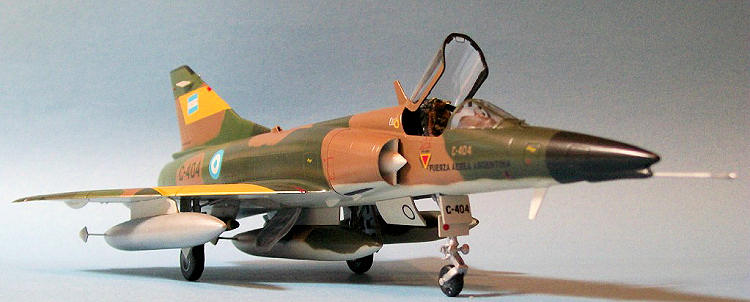
Italeri 1/48 Mirage IIIE
| KIT #: | 2634 |
| PRICE: | CAN $30.00 |
| DECALS: | Two options |
| REVIEWER: | Pablo Calcaterra |
| NOTES: |
Converted to IAI Dagger, usind RD resin
nose and Condor, Italeri, and Aerocalcas decals. Historical research by David Smith and Pablo Calcaterra |

| HISTORY |
Research carried out with David Smith
(800
This is the last Dagger shot down during the dog-fight that took place on May
21st over Gran Malvina (
This can be probably considered the last true dogfight in the 1982 war. I say so
because from that moment onwards, every time the Argentine pilots were under
attack from Sea Harriers, and knowing it was pointless to try to face the Sea
Harrier/Sidewinder combination, they tried avoid the combat and return to their
continental bases.
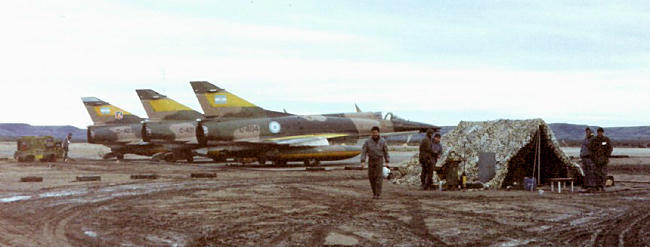 It was
May 21th during the afternoon. Two waves of Argentine attack planes had already
tried to dislodge the beachhead the Task Force was trying to establish in
It was
May 21th during the afternoon. Two waves of Argentine attack planes had already
tried to dislodge the beachhead the Task Force was trying to establish in
Two further waves were planned. As part of the third one, 2 sections of 3 Mirage
V Daggers from San Julian were to attack with 1-minute interval. They were the
sections called Lauchas and Ratones and they were supposed to attack in this
order.
The Ratones were: Captain Guillermo Donadille in C-403, Major Gustavo Piuma
Justo in C-404 and 1st Lieutenant Jorge Senn in C-407. Piuma Justo had trouble
starting the engine of his plane, so the Lauchas took the lead after Donadille
gave the authorization.
Once the problem was solved, they flew straight to the target area, as they
would be in the limit of their range. Around 80 NM from the islands, the 3
Daggers were flying skimming the waves. Though at that time the MVs did not have
any navigation equipment, based on speed and compass they were able to get to
the Sebaldes Is. Only 20 seconds late.
Just
before arriving at Gran Malvina (
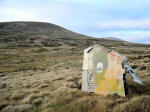 Now, flying over Gran Malvina, the planes opened their formation: the three
planes were now in a single line, side by side, 600 mt. Apart: Donadille,
navigating, in the center, Piuma to the left and Senn to his right, controlling
the air around them.
Now, flying over Gran Malvina, the planes opened their formation: the three
planes were now in a single line, side by side, 600 mt. Apart: Donadille,
navigating, in the center, Piuma to the left and Senn to his right, controlling
the air around them.
Stationed on their patrol area under the control of HMS Brillant, Sharky Ward in
Sea Harrier ZA175 (Commander of 801 Sqn flying from HMS Invincible) and his
wingman, Steve Thomas in ZA190, were turning in parallel circles over Gran
Malvina. Unknown to them, on the route the Daggers intended to take!
Weather had changed, with clouds at around 300 mts so the Argentine pilots
pulled up their dark visor. Three minutes away from the target, with the Sound
already in sight, low over the ground and having accelerated to 500 knots, Senn
warned his team mates: “Watch out, one plane to the right”. Senn had seen Thomas
passing from their right to their left, crossing above the Daggers. Donadille
looked in the direction he had been warned and saw a plane slowly overtaking
them at approximately 50
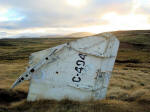 meters height and 400 farther to the right of Senn. At
first, because of the profile and dark color, Donadille thought it was a A4-B
Skyhawk, though it did not made sense to him that it was flying faster than what
a Bravo was capable of. Around this moment, Piuma Justo climbed with
afterburners turning right (to the South) knowing that the height would give him
an advantage during the combat, and from there he would be able to protect the
tail of the other two Argentine planes.
meters height and 400 farther to the right of Senn. At
first, because of the profile and dark color, Donadille thought it was a A4-B
Skyhawk, though it did not made sense to him that it was flying faster than what
a Bravo was capable of. Around this moment, Piuma Justo climbed with
afterburners turning right (to the South) knowing that the height would give him
an advantage during the combat, and from there he would be able to protect the
tail of the other two Argentine planes.
When both Harriers, flying in their parallel circuits, were turning North,
Thomas looked below and behind him and saw 2 triangles flying East fast.
Donadille and Senn. That is why Senn said that they had not been detected by the
Harriers, as Thomas only saw the Argentines when he was above them and not when
he was still to their right, about to cross their path. He alerted Ward and
immediately gave chase, turning his height into speed to try to catch the
Argentine planes.
At that instant, the dark plane that Donadille saw (Ward) turned to the left and
it is then that Donadille is able to see the plane from “above”. He immediately
realized it was a Sea Harrier. The Ratones leader commanded: “Drop ordinance and
face him”. Senn said: “He has not seen us” but Senn was talking about Thomas’
Harrier that initially had crossed above them. Senn did not realize that the
plane that Donadille was looking at (Ward) was curving to get on the tail of
Senn himself (#3). So Donadille commanded sharply: “Drop the ordinance, damn!
And break right!” So finally Senn did as he had been told and started to turn
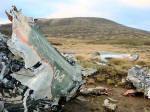 gently to his right. Besides, as we have seen, Thomas had in fact seen them.
gently to his right. Besides, as we have seen, Thomas had in fact seen them.
Ward was turning in such a way that he was going to get on Senn’s tail before
Donadille could prevent it, so in despair he fired his guns in the general
direction of Ward, who later said that he was surprised that their enemies were
staying to fight instead of continuing their path to attack the Task Force, or
even returning to their bases. At this moment, Donadille was 90 to the side of
Ward. Her firing guns illuminated the belly of the Dagger and at that moment
Ward broke to his left, now flying head on against the 2 Daggers. Donadille was
higher and Senn lower.
Finding that he had not been loaded with tracers that would have helped him to
aim better, Donadille then dove towards the head
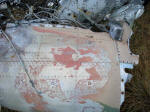 on coming and also diving Ward,
firing again this time ahead of the Harrier. If the Harrier was to cross the
trajectory of the 30 mm guns, some rounds might hit her. Focused on his aim,
Ward flew 400 mt away and below from Donadille, extremely low over the ground.
So low that Donadille considered that the Harrier might have crashed. Now
Donadille started to climb, fighting the inertia of the plane, which with the
internal tanks still full of fuel, avoided the ground by 5 to 10 meters.
on coming and also diving Ward,
firing again this time ahead of the Harrier. If the Harrier was to cross the
trajectory of the 30 mm guns, some rounds might hit her. Focused on his aim,
Ward flew 400 mt away and below from Donadille, extremely low over the ground.
So low that Donadille considered that the Harrier might have crashed. Now
Donadille started to climb, fighting the inertia of the plane, which with the
internal tanks still full of fuel, avoided the ground by 5 to 10 meters.
At this moment, unknown to Donadille, Thomas had managed to get on his tail.
Piuma was still climbing and turning right and Senn was now turning to his right
very steeply. So when Donadille started to climb, he found Senn in his path. To
avoid crashing against his wingman that had condensation trails in his wingtips,
Donadille was forced to turn left (and put his plane almost upside down) and
crossed his wingman very close.
A few seconds later, turning again to his right, and trying to see what had
happened to the Harrier he had fired at, Donadille received the impact of the
first of Thomas’ missiles. The damaged Dagger went into “porpoise” (sudden up
and down movements) and a few meters above the ground it went into a flat spin.
The control of his plane lost, Donadille ejected and no more than 20 seconds
later, he touched the ground. Approximately 500 meters ahead of him, his Dagger
crashed and erupted in flames.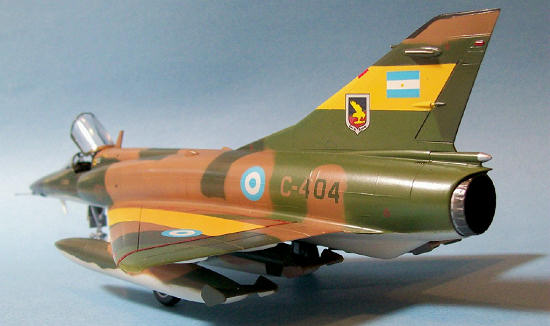
By now, Piuma had levelled his plane and was able to see the combat taking place
below him, on his right side. Two Sea Harriers were getting on Senn’s tail who
had now reversed his turn, going to his left (West) and trying to face the
threat on his tail: Ward doing a turn that really surprised Piuma watching from
above as it was really tight (one of the great advantages of the Harrier) and
another one, Thomas, approximately 700 meters away and below, 90 degrees from
the tail of the Dagger. The missile left the left wing of Thomas’ Harrier and
Piuma shouted to Senn to break his turn, but the Sidewinder ate the distance in
a very short time and C-407 was hit above the left wing, close to the tail.
Piuma called Donadille on the radio, but of course received no answer. Then he
saw the second Harrier (Ward) gently turning to the left (North) below him at
around 40 meters over the ground. The last Argentine pilot dove on the
unsuspecting Ward. Ward and Thomas had started to fly together in a CAP again,
flying East. Piuma got inside Ward’s turn and 600 meters away, 30 degrees to the
left and slightly above the Harrier he fired a long burst at Ward. Piuma stop
firing when he realized he also did not have tracers.
The Harrier went into a valley and Piuma thought that Ward was not
going to get away from him. At that moment, he was doing 450 knots and was now
40 meters above the ground. He saw a pilot hanging from his parachute (Senn).
After looking at the pilot hanging from the parachute, Piuma felt a great
explosion on his plane. He ejected when he felt the heat of his plane on fire.
Ward and Thomas had seen a Dagger flying lower than them running Northeast. Ward
got under and behind the tail of the last Dagger and fired his missile. The
plane cartwheeled after exploding. Piuma had overtaken the Harriers and got
fired by his intended target.
The 3 Daggers were shot down and potential more damages to the British Task
Force were prevented (on this day, out of the 7 warships that entered the Sound,
5 were hit: HMS Ardent sinking the following day, HMS Antrim and Argonaut were
badly mauled 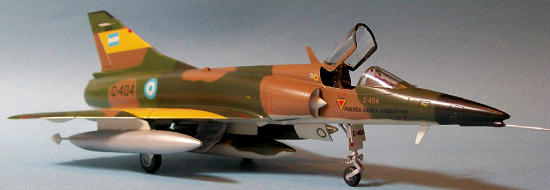 and forced to leave the zone of operations for the rest of the war,
HMS Brillant and Broadsword were damaged). Only two days later did the Argentine
planes started to hit the transport ships, but by then it was too late and the
beachhead was firmly established.
and forced to leave the zone of operations for the rest of the war,
HMS Brillant and Broadsword were damaged). Only two days later did the Argentine
planes started to hit the transport ships, but by then it was too late and the
beachhead was firmly established.
After resuming their patrol, the two Harrier pilots lost sight of each other.
Ward was afraid that Thomas had been shot down, as he was not answering his
calls. Upon landing back in HMS Invincible, Ward found that Thomas had just
landed, his plane damaged by 3 rounds in the electronics bay in the tail area.
Apparently, he was hit by a machine gun of the Argentine Army while flying low
over Fox Bay.
The Argentine pilots spent the night in the open, Piuma injured and barely able to walk, Donadille with his eyesight affected by the ejection and Senn in good physical shape. It would take them between 1 and 2 days in the open before they were rescued by the Argentine forces and then be returned to the continent in one of the several H-130 flights of the Argentine Air Force that broke almost daily the blockade imposed by the Task Force. But their rescue is another (long and interesting) story…
| THE KIT |
I built the plane using the old Esci kit (raised panels, not very well
engineered). Decals are much better than the previous issue (late 80s?)
It has 2 types of drop tanks, some bombs, 3 types of missiles (including the
Matra 550 used by the Argentine Air Force during the war in their MIIIs) and
decals for several versions: Australian, Spanish, French, Swiss. Two exhaust
types (C and E version) are supplied. So there are plenty of versions to be
built with this kit.
This kit has been reissued a few years ago and competes with low cost against the Eduard kit.
| CONSTRUCTION |
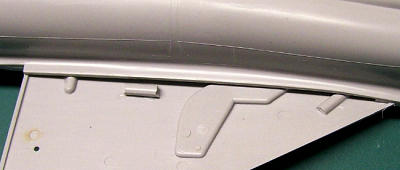 The steps that I took are as follows:
The steps that I took are as follows:
To improve the union of the wings-fuselage, I cut some pieces of plastic sprue
and placed them below the union of the parts.
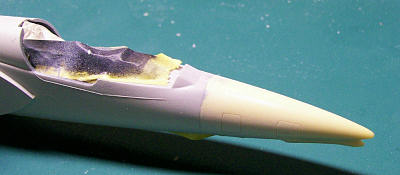 The nose is a resin
one that replaces the Mirage III. I needed some putty to improve the union of
the parts. There are some little antennas with an “oval” base on the tail. I cut
these shapes from plastic and used Putty to improve the union. I added some
weight around the cockpit to
The nose is a resin
one that replaces the Mirage III. I needed some putty to improve the union of
the parts. There are some little antennas with an “oval” base on the tail. I cut
these shapes from plastic and used Putty to improve the union. I added some
weight around the cockpit to
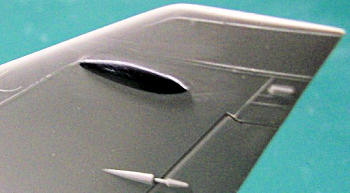 prevent the plane from becoming a tail sitter.
prevent the plane from becoming a tail sitter.
As the planes flew with 3 drop tanks and the kit brings 2, I copied an extra one
casting a rubber molde and making the piece with 2 part resin (Araldite).
The bombs are from the Hobby Craft A4 Skyhawks kit, but I modified the tail (using a previously scratchbuilt and casted rubber molde) to represent the version with parachute to slow down them and give time for the bomb to get armed. The fins were made using an old credit card.
| COLORS & MARKINGS |
 I used ModelMaster Acrylic paints. First I used Light grey (4766) for all the
undersurfaces, followed by Tan (4709), then Medium Green (4734) and finally Dark
Green (4726). The lines between colours are smooth so I used Blue Tac to obtain
the desired effect.
I used ModelMaster Acrylic paints. First I used Light grey (4766) for all the
undersurfaces, followed by Tan (4709), then Medium Green (4734) and finally Dark
Green (4726). The lines between colours are smooth so I used Blue Tac to obtain
the desired effect.
The yellow (4683) ID
bands were painted on wings and tail. Some of the yellow managed to get under
th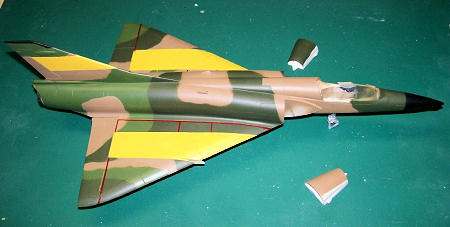 e masking tape so I had to retouch the cammo colors. I also painted the red
stripes on the wings.
e masking tape so I had to retouch the cammo colors. I also painted the red
stripes on the wings.
As the Air Force was running short of drop tanks, some of the ones used were not
painted at all. So I chose to paint one in aluminium.
Future gave a gloss surface for the decals: a mix of Italieri (some stencils), Condor Decals (badge on the tail) and AeroCalcas.
| FINAL CONSTRUCTION |
 The air
intakes and legs were added.
The air
intakes and legs were added.
Finally, a coat of semi gloss clear barnish from AeroMaster to seal the decals.
The last details were the antenna on the nose (scratchbuilt), the one in front of the windshield, the gunsight, the supports for the air intakes (scratchbuilt), 2 VHF antennas (scratch), 2 antennas on the tail (scratch), Pavla seat, rear mirrors and handles for the canopy, position lights, wheels and doors for the wheels wells.
| CONCLUSIONS |
As there is no Mirage V in 1/48 available the only way to get my second IAI
Dagger was by tackling this challenging project that took more than 3 months to
complete. Our special thanks to
·
Guillermo Donadille, Gustavo Piuma Justo and Steve Thomas for their patience and
time
·
Allan White for the recent pictures of the crashed plane taken specially for
this article
·
Claudio Marcos of the Argentine Air Force, for the picture of the plane during
the war, days before it was shot down.
Pablo Calcaterra
and David Smith
If you would like your product reviewed fairly and quickly, please contact me or see other details in the Note to Contributors.